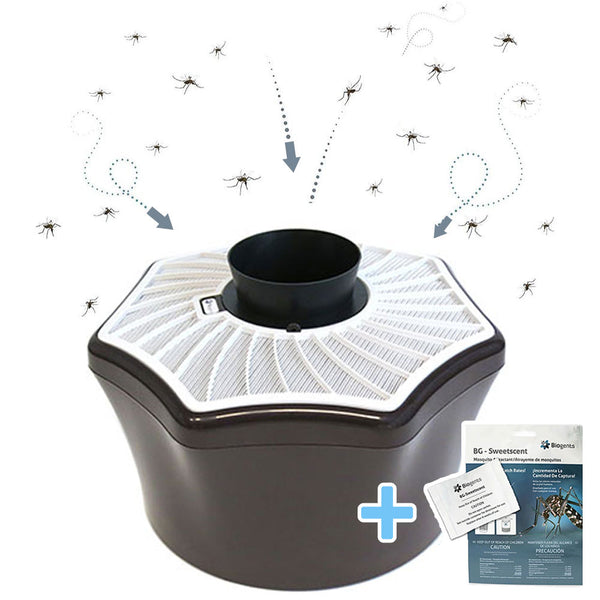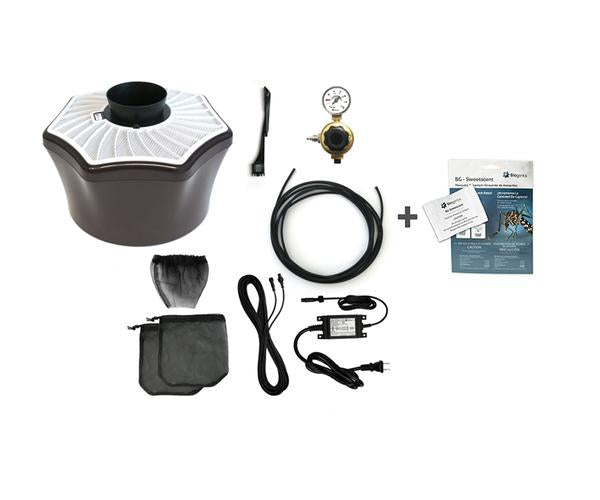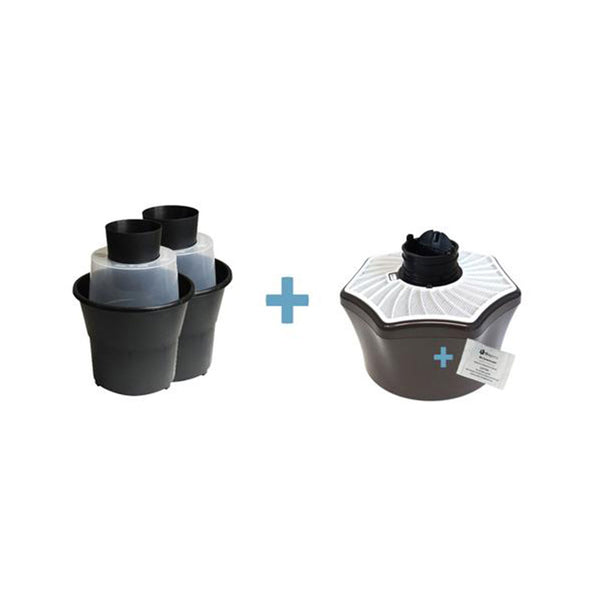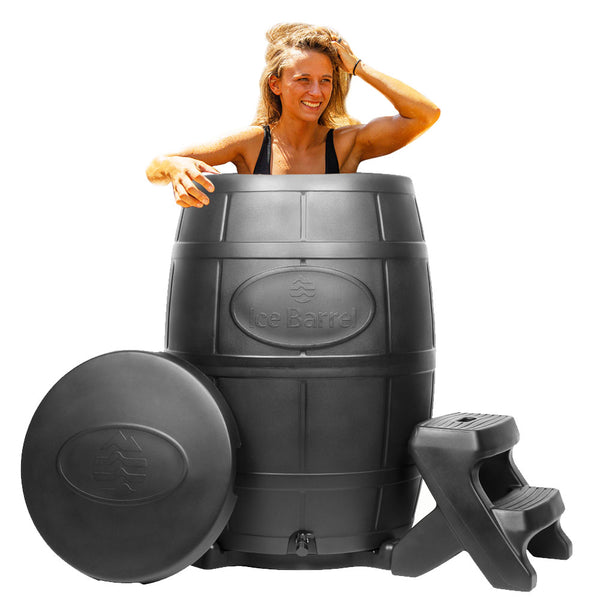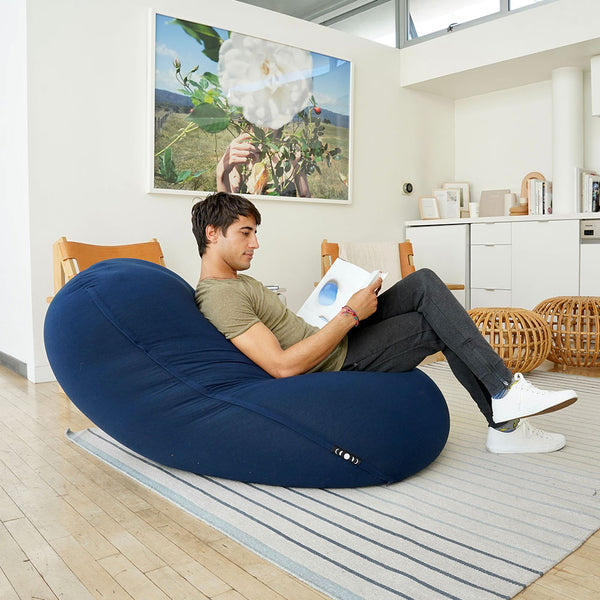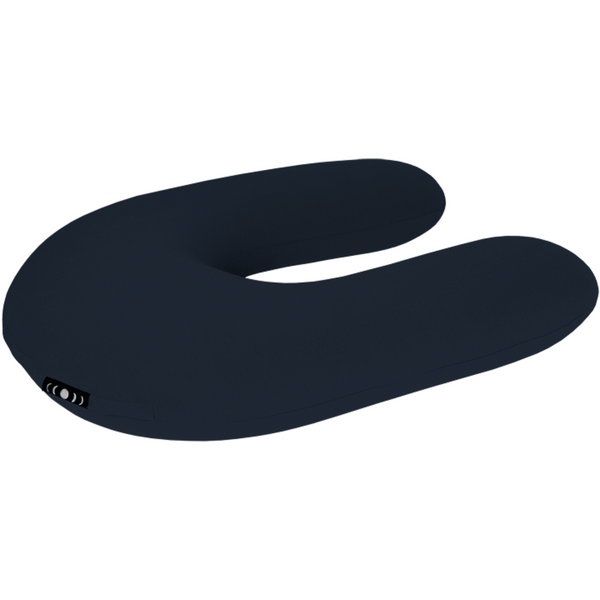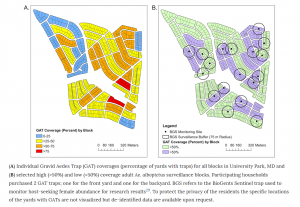Scientific foundation and publications
Biogents’ mosquito traps were invented by scientists who have been doing research on the behaviour of mosquitoes and other blood-sucking insects for over 16 years. The scientific foundation of Biogents mosquito traps are more than 300 publications that document the exceptional capture rates.
Useful applications and a number of patents have resulted from sound fundamental research at the University of Regensburg. Capture devices originally built for fellow researchers and specialists have evolved into fully developed products within a short period of time. All trap types are based on the same patented
technology and differ only in design.
The trap type for researchers, the BG-Sentinel, already became one of the leading traps for monitoring tiger mosquitoes and other species within just a few years after its invention in 2004. A steadily growing number of independent scientific publications reviewed by experts supply impressive evidence of the widespread use of Biogents traps. E.g., a study in Cesena, Italy, shows a reduction of mosquito bites up to 85 % in areas with Biogents traps, see below. CDC mentions the BG-Sentinel traps as currently most commonly used adult traps for Ae. aegypti and Ae. albopictus (CDC-PDF about surveillance and control on the USA >).
Collection of publications
 List of studies with Biogents traps >
List of studies with Biogents traps >
 List of scientific publications of our researchers >
List of scientific publications of our researchers >
Online database with publications on studies using the BG-Sentinel >
Selected studies:
Control effect:
 Download the selected studies that show the control effect of Biogents traps as a PDF >
Download the selected studies that show the control effect of Biogents traps as a PDF >
- Field tests of mosquito lures and traps >
- Neighbors help neighbors control urban mosquitoes >
- Effectiveness of a field trap barrier system for controlling Aedes albopictus: biting pressure reduction to almost zero >
- Up to 87% reduction of Aedes albopictus nuisance in Italy >
- Mass trapping of Dengue Vectors with BG-Sentinel Traps >
Monitoring
Degener et al. 2019: Field tests of mosquito lures and traps
The growing spread of the invasive mosquito species Aedes aegypti (L.) and Aedes albopictus (Skuse) increases the complexity of mosquito control. In contrast to several other mosquito species that are found in the home environment, such as the house mosquito Culex quinquefasciatus, the container-inhabiting tiger mosquitoes are day-active. Adulticidal operations at daytime are not feasible and reaching all breeding sites in larviciding operations is practically impossible. Many home owners use mosquito traps to reduce mosquito populations in their backyards. Several traps with different attraction mechanisms and price categories are commercially available, but most of these traps were not scientifically proven to be effective.
The Biogents BG-Sentinel trap has been used by researchers all over the world for over a decade to monitor dengue vectors and is generally recognized as the gold standard mosquito trap for yellow fever and Asian tiger mosquitoes. The trap uses the BG-Sweetscent, an artificial human skin scent that contains lactic acid. The BG-Sentinel can additionally be operated with CO2 to increase catch rates and species spectrum. The commercially available BG-Mosquitaire trap uses the same mosquito attraction and collecting mechanisms as the BG-Sentinel, but instead of being lightweight and collapsible for scientific or public health purposes, it was designed to be more robust and visually pleasing, for use in fixed positions throughout the whole mosquito season in backyards, restaurants, hotels, and similar locations.
The study answered three questions:
1) Do tiger mosquito catch rates of other commercially available mosquito traps increase when adding the BG-sweetscent lure?
Yes – catch rates of tiger mosquitoes in different UV light mosquito traps increased up to 4.2-fold.

Fig 1. Biogents BG-Sweetscent increases Asian tiger mosquito catch rates in commercially available mosquito traps.
2) Is the commercially available BG-Mosquitaire trap as good as the professional BG-Sentinel trap?
Yes, there was no statistical difference between the Ae. aegypti and the Culex quinquefasciatus catch rates of the two traps, neither when tested with (Fig. 2 A), nor without CO2.

Fig 2. Boxplots of Aedes aegypti (female and male) catches in BG-Mosquitaire and BG-Sentinel traps (A) in Clovis,CA, and (B) New Orleans. The same letters indicate insignificant different catch rates.
3) Is the BG-Mosquitaire trap with and without CO2 better than two other mosquito traps that need to be obligatorily operated with CO2?
Without CO2, the BG-Mosquitaire with BG-Sweetscent is already as good as the Mosquito Magnet Patriot, and better than the SkeeterVac SV3100. With CO2, the BG-Mosquitaire collects seven to twelve times more Ae. albopictus than the other two traps

Fig. 3. Boxplots of (A) Aedes albopictus (female and male) in 4 different mosquito traps in Lake Charles, LA. Please note that 2 outliers (302 and 523 Ae. albopictus in the BG-Mosquitaire+Sweetscent+CO2) are not shown in order to facilitate visual comparison between boxes. Different letters indicate significantly different catch rates.
Read more about the results in the publication:
Degener CM, Geier M, Kline DAN, Urban J, Willis S. 2019. Field trials to evaluate the effectiveness of the BG-Sweetscent lure in combination with several commercial mosquito traps and to assess the effectiveness of the BG-Mosquitaire trap with and without carbon dioxide. 35(1):32–39. doi:10.1038/s41598-018-34161-9.
Johnson et al. (2018): Neighbors help neighbors control urban mosquitoes
Government-led programs to control dengue have often failed. Urban Aedes mosquitoes such as the yellow fever mosquito Ae. aegypti and the asian tiger mosquito Ae. albopictus mainly breed in small containers on private properties. They therefore seem to be great species to be targeted by control programs that strongly rely on citizen participation.
The town of University Park, MD, USA used the BG-GAT traps in a citizen-based mosquito control intervention. The town is highly infested with Ae. albopictus and comprises approximately 1000 residential yards. The approach named Citizen Action through Science (Citizen AcTS) is based on citizen volunteers that are mentored by scientific advisors. Residents were encouraged to purchase two BG-GAT traps (one for the front- and one for the back yard). Each block of houses had a community leader that informed their neighbors about the initiative. Every participant was responsable for the installation and maintenance of the purchased traps.
Almost the half of the town’s residential yards (439 of 954) were equipped with GATs. Results indicate effective mosquito control, however the reduction of mosquito nuissance was significantly higher in blocks, where more than 80% of households used GAT traps (Fig. 1).

Fig. 1 Mean (±SE) female Ae. albopictus abundance during each collection point in high (≥80%) and low (<80%) coverage monitoring sites. Different letters or presence of ’**’ indicate statistical significance between observations (P < 0.05).
Read more about the results in the publication:
Johnson BJ, Brosch D, Christiansen A, Wells E, Wells M, Bhandoola AF, Milne A, Garrison S, Fonseca DM. 2018. Neighbors help neighbors control urban mosquitoes. Sci Rep. 8(1):15797. doi:10.1038/s41598-018-34161-9.
Akhoundi et al., 2018: Effectiveness of a field trap barrier system for controlling Aedes albopictus: a “removal trapping” strategy
A barrier system of Biogents traps with CO2 to protect houses from Tiger mosquitoes Aedes albopictus
A scientific study from southern France demonstrated the potential of Biogents traps to significantly reduce Asian tiger mosquito biting pressure to almost zero:
Three houses with garden were treated with a network Biogents traps that were operated with CO2 and BG-Lure for 3 months during the peak activity season of Ae. albopictus. The average distance between the traps was 5 m. The three treated properties received 9, 13, and 18 traps, depending on their size (Fig. 1a-c). The trap network is called “Bio-Belt Anti-Moustique” and was patented by the French company HBM Distribution SAS.
The mosquito biting pressure in outdoor areas of the three treated houses was compared to the biting pressure in three untreated houses with similar environments. An effect of the trap barrier is visible from the time, when traps were turned on (vertical dashed line in Fig. 2). After three weeks of continous trapping, the biting pressure was substantially reduced in the houses that were protected by traps, in comparison to untreated houses, and after six weeks, the biting pressure was reduced to almost zero.
Fig 1: Biobelt traps installation in the treated houses. a-c Spatial schematic depiction of the array of the “belt” of traps around three treated houses, prospected in the area Modules- traps are shown in green. The area protected by the barrier is hatched

Fig. 2: Weekly mean Ae. albopictus biting pressure in three houses with BG-Sentinel trap barrier system and in three untreated control houses in southern France, July – Sept 2016. The dashed vertical line indicates when the trap barrier system was turned on.
Read more about the results in the publication:
Akhoundi M, Jourdain F, Chandre F, Delaunay P, Roiz D. 2018. Effectiveness of a field trap barrier system for controlling Aedes albopictus: a “removal trapping” strategy. Parasit Vectors. 11(1):101. doi:10.1186/s13071-018-2691-1.
Englbrecht et al. 2015: Reduction of Aedes albopictus nuisance in Italy.
In Europe, Italy is one of the countries, that are heavily infested with the day-active Asian tiger mosquitoes (Aedes albopictus). This study showed that it is possible to reduce biting rates and local populations of Aedes albopictus in Cesena, Italy, by using Biogents suction traps:
For the experiment, 3 small intervention sites with different characteristics were selected: a) single-family house surrounded by a garden, b) area dominated by apartment houses, c) cemetery. The mosquito biting pressure in outdoor areas of the three areas was compared to those in three untreated similar environments by human landing collections (the lower legs of an investigator were exposed to mosquitoes, and landing mosquitoes were collected, identified and counted). The study duration was 16 weeks from June to October. From the beginning of the study, the biting pressure was lower in areas with Biogents suction traps, but after 5 weeks, the effect of trapping on mosquito nuisance became more evident. Over the course of the whole study, an average of 11.2 Ae. albopictus per hour were collected by human landing collections in areas without Biogents traps, while only an average of 1.4 Ae. albopictus per hour were collected in areas with Biogents traps. This means, that the overall biting pressure in intervention areas was reduced by 87% (Fig. 1).

Fig. 1: Mean number of Aedes albopictus bites per hour in human landing collection at three intervention sites treated with Biogents traps, and three similar sites without traps in Cesena, Italy.
Read more about the results in the publication:
Englbrecht C, Gordon S, Venturelli C, Rose A, Geier M. 2015. Evaluation of BG-Sentinel Trap as a Management Tool to Reduce Aedes albopictus Nuisance in an Urban Environment in Italy. J Am Mosq Control Assoc. 31(1):16–25. doi:10.2987/14-6444.1.
A Study measured mosquito bites on test persons in areas equipped with Biogents traps versus areas not equipped with Biogents traps in Cesena, Italy, in collaboration with the Department of Public Health, Local Health Services. Up to 85% less mosquito bites could be achieved in the areas with Biogents traps
Degener et al. 2014: Mass trapping of Dengue Vectors with BG-Sentinel Traps
Aedes aegypti, the main vector of viral diseases such as dengue, Zika and chikungunya, is highly adapted to urban areas. Routinely employed dengue vector control strategies, that usually consist of the reduction of breeding sites and application of insecticides, have failed to control virus transmission in most settings, including Brazil. This long-term study shows that Biogents suction traps can reduce the abundance of Aedes aegypti in urban settings. The study that was co-financed by the world-bank was conducted over 18 months in Manaus, Brazil. Six mass trapping areas (areas where on average 60% of households received a Biogents suction trap for constant mosquito trapping) and six control areas (areas without trapping intervention) were selected in the same neighborhood. The mass trapping areas included a total of 734 houses, 444 of which accepted a Biogents suction trap for constant use, and the control areas comprised 753 houses. The effect of the intervention was monitored by installing 4 BG-Sentinel monitoring traps in all 6 intervention and all six control areas for 24 h once every two weeks.
Monitoring indicated that the mass trapping intervention significantly reduced the abundance of adult female Ae. aegypti during the first five rainy months of the study. Additionally, recent dengue infections were less common in participating houses of mass trapping areas. The majority (88%) of 235 inhabitants from the mass trapping areas that participated in a questionnaire reported that the trap perceptibly reduced both mosquito density and nuisance.

Fig. 1: Comparison of mean numbers of collected female Aedes aegypti in monitoring traps in six mass trapping areas and six reference areas (areas without trapping intervention) before trap installation and during the first rainy season of the long-term study.
Read more about the results in the publication:
Degener CM, Eiras E, Zara TMF, Roque RA, Rösner S, Codeço CT, Nobre AA, Rocha ESO, Kroon EG, Ohly JJ, et al. 2014. Evaluation of the Effectiveness of Mass Trapping With BG-Sentinel Traps for Dengue Vector Control: A Cluster Randomized Controlled Trial in Manaus, Brazil. J Med Entomol. 51(2):408–420. doi:10.1603/ME13107.
Unlu et a.. 2014: Multiyear Surveillance for Aedes albopictus with Biogents Sentinel Trap Counts for Males and Species Composition of Other Mosquito Species
40 to 50 BGS traps were utilized during an intensive 5-year surveillance as part of an ‘Area-wide Management Program for the Asian Tiger Mosquito’ in NJ, USA. The results are now published. The authors say that the Biogents Sentinel (BGS) trap is a very effective tool to monitor adult populations of Aedes albopictus and that although BGS traps are becoming the gold standard instrument for Ae. albopictus surveillance, they can also be used to collect other important mosquito species, which can enhance existing vector surveillance programs.
Read more about the results in the publication:
Unlu I., Farajollahi A. (2014) Multiyear Surveillance for Aedes albopictus with Biogents Sentinel Trap Counts for Males and Species Composition of Other Mosquito Species. Journal of the American Mosquito Control Association, 30(2):122-125.
DOI: http://dx.doi.org/10.2987/14-6401.1
Lühken et al. (2014): Comparison of 4 traps used for mosquito monitoring and surveillance programs: The BG-Sentinel trap is probably the best solution
Four different traps, Biogents Sentinel trap (BG trap), Heavy Duty Encephalitis Vector Survey trap (EVS trap), Centres for Disease Control miniature light trap (CDC trap) and Mosquito Magnet Patriot Mosquito trap (MM trap) were compared in a 4×4 latin square study. In the years 2012 and 2013, more than seventy 24-hour trap comparisons were conducted at ten different locations in northern and southern Germany, representing urban, forest and floodplain biotopes.
Conclusion: The autors say that the BG trap showed a significantly better or similar performance compared to the CDC, EVS or MM trap with regard to trapping efficacy for most common mosquito species in Germany, including diversity of mosquito species and number of mosquitoes per trapping period. Thus, they say, the BG trap is probably the best solution for general monitoring or surveillance programs of adult mosquitoes in Central Europe.
Read more about the results in the publication:
Lühken et al. (2014) Field evaluation of four widely used mosquito traps in Central Europe.Parasites & Vectors 2014, 7:268
doi:10.1186/1756-3305-7-268










